Two total lunar eclipses occur this year, the first since late 2015, in January and July. Meanwhile, three solar eclipses take place in 2018 — all of them only partial cover-ups.
If you're one of the estimated 154 million U.S. adults who watched the solar eclipse on August 21, 2017 — and that's most of us! — you know how incredible such events can be. So when will the ones in 2018 occur? Read on to find out!
Up to seven eclipses of the Sun and Moon can take place in one year, though the last time that happened was 1982, and the fewest possible is four. This year we'll get three solar eclipses (alas, all partial events) and two total lunar eclipses spaced six months apart.
Why Do Eclipses Happen?
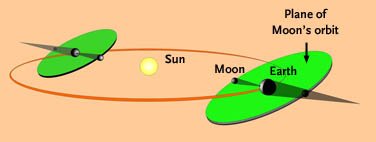
Jay Anderson
A solar eclipse, such as the one in August 2017, occurs only at new Moon, when the lunar disk passes directly between us and the Sun and the Moon's shadow falls somewhere on Earth's surface.
Conversely, a lunar eclipse takes place during full Moon, when our satellite passes through Earth's shadow.
These alignments don't happen at every new and full Moon because the lunar orbit is tipped about 5° to Earth's orbital plane — only occasionally do the Sun, Earth, and Moon line up exactly enough for an eclipse to occur. (The technical name for that, by the way, is syzygy.)
Three types of lunar eclipse are possible (total, partial, and penumbral) depending on how deeply the full Moon plunges into or near the umbra, our planet's dark, central shadow.
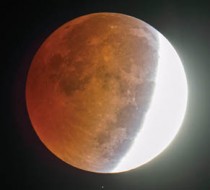
Johnny Horne
If it goes all the way in, we see a total lunar eclipse that's preceded and followed by partial phases. That was the case during the widely viewed event in September 2015, which marked the conclusion of a series of four consecutive total lunar eclipses in 2014–15! Such eclipse tetrads are not common — the last one occurred during 2003–04, but the next won't begin until 2032.
If the Moon skims part way into the umbra, as shown at right, only the partial phases occur — you'll see part of the Moon in nearly full sunlight, and part of it steeped in the deep, red-tinged umbral shadow.
And if its disk passes just outside the umbra, it still encounters the weak penumbral shadow cast by Earth. A sharp-eyed observer will notice that one side of the full Moon's disk looks a little dusky.
Fortunately, every lunar eclipse is observable anywhere on Earth where the Moon is above the horizon. (But there's still an element of luck involved — after all, the sky has to be clear!)
However, solar eclipses more tightly restrict where you can see them because the Moon casts a smaller shadow than Earth does.
If the Moon completely hides the Sun, the eclipse is considered total. With its brilliant disk completely covered, the Sun's ghostly white outer atmosphere is momentarily revealed for durations from seconds to several minutes. In November 2013, for example, planeloads of eclipse-chasers converged in a remote portion of northern Kenya to watch just 11 seconds of totality.
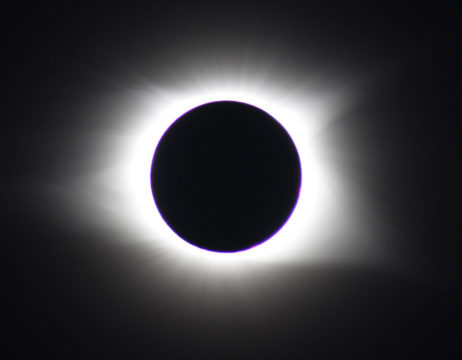
Sky & Telescope / Kelly Beatty
A completely eclipsed Sun can be viewed only from a narrow track or path on Earth's surface that's typically just 100 miles (160 km) wide. Outside of that path, about half of the daylit hemisphere of Earth is able to watch a partial eclipse as the Moon obscures a portion of the Sun.
Occasionally the Moon passes directly in front of the Sun but doesn't completely cover it. When that occurs, it's usually because the Moon is farther from Earth than its average distance. (The Moon's orbit isn't perfectly circular; its eccentricity is about 5%.)
This geometric circumstance is known as an annular eclipse, so-called because you can see a ring, or annulus, of sunlight surrounding the lunar disk. Annular eclipses of the Sun occur about as often as the total ones do, and an annular's path is likewise narrow. Outside of it observers see only a partial cover-up.
The Five Eclipses in 2018
Below are brief descriptions of this eclipses in 2018 of the Sun and Moon. You'll find more details Sky & Telescope magazine as the date of each draws near. Times are in Universal Time (UT) except as noted. Adjust these to get those for your time zone (e.g. PST = UT – 8, EST = UT – 5).
January 31: Total Lunar Eclipse
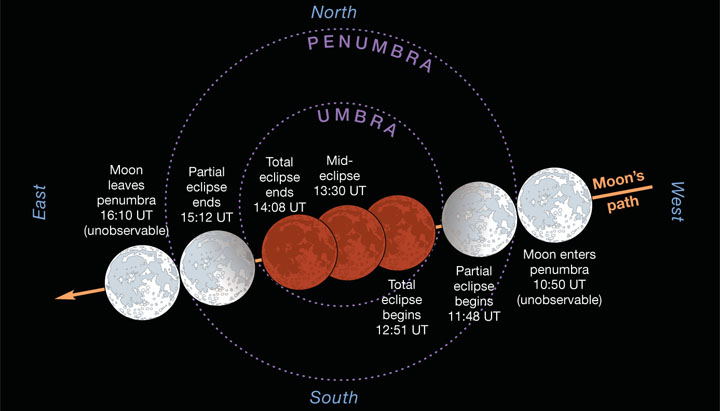
S&T / Leah Tiscione
It's been more than two years since we've experienced a total lunar eclipse — the last one was September 27–28, 2015 — and skygazers are ready for another! As the graphic at right shows, the eclipse will last almost 3½ hours from the beginning of the partial phase at 11:48 UT until it ends at 15:12 UT. Totality lasts a generous 77 minutes, from 12:51 to 14:08 UT.
The timing of this one, with mid-eclipse at 13:30 UT, favors locations around the Pacific Rim: not long after sunset for eastern Asia and Australia; around midnight for Hawaii; and and before dawn for western North America. This animation by Larry Koehn shows how the event plays out for the principal North American time zones, plus Hawaii.
But not all of the U.S. will enjoy the show. As the map below shows, totality occurs in the hours before dawn for those on the West Coast, but it happens after moonset (and sunrise) for those east of the Mississippi River. In fact, those as far east as Boston won't get to see more than a small umbral nibble on the lunar disk. More information about this eclipse.
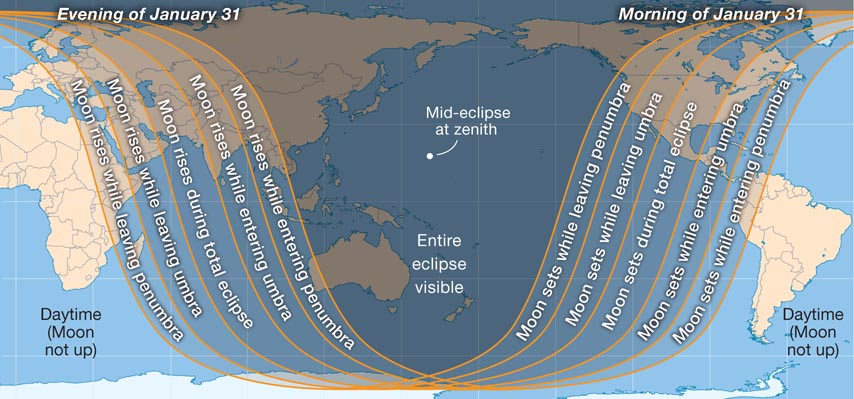
S&T / Leah Tiscione
February 15: Partial Solar Eclipse
All three of this year's partial solar eclipses occur deep in the Southern Hemisphere. The first one is ideal if you're a penguin — the maximum (60% of the Sun's diameter covered) occurs at 20:51 UT along the coast of Queen Maud Land abutting the South Atlantic Ocean. Most Chileans and Argentinians will see up to 40% of the Sun covered. Those of you at the South pole will see the Moon cover 51% of the solar disk's area. More information about this eclipse.
Note that solar-eclipse predictors compute the Sun's blockage during partial eclipses in two ways. Magnitude refers to the fraction of the solar disk's diameter that is covered by Moon, whereas obscuration corresponds to the fraction of the disk's area that's covered. So, for example, at this eclipse's maximum as seen from Buenos Aires, the magnitude is 17% but the obscuration is only 8%.
July 13: Partial Solar Eclipse
The viewing prospects are even worse for this partial solar eclipse, because the Moon's shadow clips Earth between the the coasts of Australia and Antarctica. France's Dumont d'Urville scientific station on the Antarctic coast should enjoy this event's "greatest eclipse," when a third of the Sun's diameter is covered at 3:01 UT. Residents of Hobart, Tasmania, will see their biggest small bite in the Sun at 3:35 UT. More information about this eclipse.
July 27: Total Lunar Eclipse
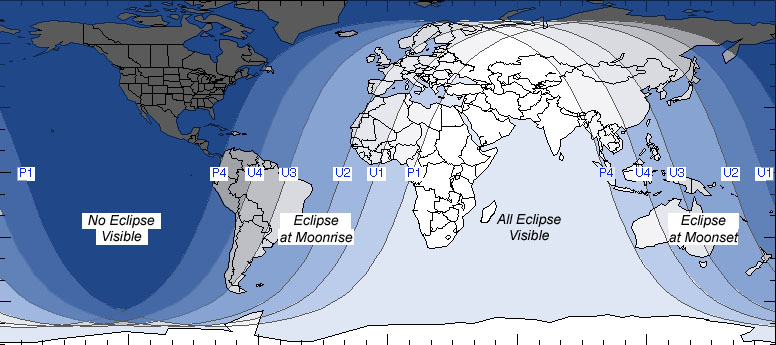
Fred Espenak / eclipsewise.com
Two weeks after the new Moon involved in a July 13th's partial solar eclipse, the full Moon takes a deep dive through Earth's umbra for the second time this year. Mid-eclipse on July 27th comes at 20:22 UT, which unfortunately is in the midst of daylight across North America.
But it will be a grand show across Europe, Africa, Asia, and Australia. The partial phases run from 18:24 to 22:19 UT, nearly 4 full hours, which results from two factors. First, the Moon passes directly through the heart of Earth's umbral shadow, just 6 arcminutes from its center. Second, the Moon is very nearly its most distant from Earth, near the apogee of its orbit, resulting in a slightly diminished orbital velocity. Totality lasts a generous 1¾ hours, from 19:30 to 21:13 UT. More information about this eclipse.
August 11: Partial Solar Eclipse
Two weeks later, with the Moon having moved halfway around its orbit and once again new, another partial solar eclipse takes place — the third and final one in 2018. This time the geometry shifts from extreme southern latitudes to extreme northern ones. Greatest eclipse, at 9:46 UT, takes place off the northern coast of Siberia at a latitude of 70.4° north, well above the Arctic Circle. From that location one could see 74% of the Sun's diameter covered.
Much of Scandinavia, Russia, and eastern Asia enjoy a partial eclipse that day. The maximum obscuration is 30% in Ulaanbatar, Mongolia; 23% in Beijing and Novosibirsk; and just 1% in Stockholm. More information about this eclipse.
Looking Ahead to 2019
The mix of events gets more interesting next year, with three different flavors of solar eclipse — one each of partial, annular, and total — and partial and total lunar eclipses. The Moon's deep umbral dive on January 21, 2019, will offer ringside seats for skywatchers in North and South America.
 4
4
Comments
Graham-Wolf
December 28, 2017 at 8:43 pm
Great article Kelly, BUT....
OMG!
None of these events are actually visible from NZ.
Hey... I know you really tried so hard.
Will read with interest how they turn out for "others" on the big days, ahead.
Plenty to choose from, if you're in the geographical sweet-spot.
Good luck to 'em!
Regards from Graham W. Wolf
46 South, Dunedin, NZ.
You must be logged in to post a comment.
J. Kelly BeattyPost Author
December 29, 2017 at 9:53 am
Graham, I would never, EVER disappoint you. I believe you'll be able to see BOTH of the total lunar eclipses, the second one just before sunrise on July 28th. Enjoy!
You must be logged in to post a comment.
December 29, 2017 at 3:36 pm
I agree with G-W, very good article, as always. Unfortunately I will not be able to see any of these events from here in North Carolina except possibly the very begining of the Jan. 31 eclipse. I also missed the August total eclipse because it was cloudy; only saw a little of partial before and after. One thing I have learned in my over 60 years (I'm now 72) of being an amateur astronomer is patience; oh, and that astronomy is a fickle mistress. Keep up the good work.
You must be logged in to post a comment.
Graham-Wolf
December 30, 2017 at 9:01 pm
Hi Kelly
Point taken.... absolutely correct on both accounts!!
Down here in Dunedin (46 South), we've had cyber attacks on Google, so your original article the other day, was only partially complete and much mutilated. We've also had D.O.S. attacks this month (it's that crazy time of the year). Had another read moments ago, and your full (restored) article does indeed show two lunar eclipses visible from NZ. Fred Espenak's Eclipse site also has some wonderful resources, but haven't got round to accessing them lately.
The total Lunar Eclipse on Jan 31st certainly looks a beaut.
A long 77 minutes of Totality (the 2000 Total Lunar Eclipse lasted a record/near record 120+ minutes, I hazily recall), so plenty of possible shadow crater timings to do.
Thanks once again, Kelly, for a great article!
Best wishes for 2018.
It's now all in the hands of the weather Gods/ Murphy.
Graham W. Wolf
You must be logged in to post a comment.
You must be logged in to post a comment.